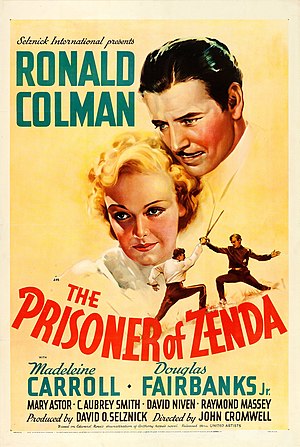The Prisoner of Zenda (1937 film)
| The Prisoner of Zenda (1937 film) | ||||||||||||||||||||||||||||
|---|---|---|---|---|---|---|---|---|---|---|---|---|---|---|---|---|---|---|---|---|---|---|---|---|---|---|---|---|
This film has been preserved in the National Film Registry in 1991.
| ||||||||||||||||||||||||||||
 | ||||||||||||||||||||||||||||
|
The Prisoner of Zenda is a 1937 American black-and-white adventure film based on Anthony Hope's 1894 novel of the same name and the 1896 play.
The film starred Ronald Colman, Madeleine Carroll and Douglas Fairbanks Jr., with a supporting cast including C. Aubrey Smith, Raymond Massey, Mary Astor and David Niven. It was directed by John Cromwell, produced by David O. Selznick for Selznick International Pictures, and distributed by United Artists. The screenplay was written by John L. Balderston, adapted by Wells Root from the novel, with dramatization by Edward Rose; Donald Ogden Stewart was responsible for additional dialogue, and Ben Hecht and Sidney Howard made uncredited contributions.
Why It Rocks
- Throughout history, there have been multiple cinematic adaptations of the legendary adventure novel, this version is the one usually seen as the most definite version of the tale, as not only is the film incredibly faithful to the novel it's based on, but the changes that were made for the film blend in very well.
- The film dispenses with most of the novel's descriptive scenes, since they would have been too expensive to film.
- A coronation parade through the streets of the Ruritanian capital was discarded in the film adaptation, along with long chases through the country side.
- The movie speeds up the romance between Rassendyll and Flavia, lowers the body count early on, and adds more business to Rupert of Hentzau -- a villain who was already so compelling Anthony Hope gave him his own sequel.
- This version is also notable for being the first sound cinematic adaptation after the previous ones being silent versions. Along with the profound way it deals with its themes of loyalty and devotion to the throne. In the role of Rassendyll is Ronald Colman who, throughout his career, embodied the noble virtues of the gentleman adventurer.
- Even though the plot of the film is fairly simple and had been done numerous times before -- the ruler of a kingdom is drugged and has to be impersonated by a lookalike lest kingdom fall into hands of evil half-brother -- the writers managed to turn it into something unique and memorable with the tale becoming a stylish tale of love, intrigue, and derring-do, that never drags on.
- Amazing performances from the entire cast that translate perfectly to the screen. Ronald Colman is just incredible in his dual role as English gentleman Rudolf Rassendyll, and King Rudolph V.
- The additional roles such as Madeleine Carroll as Princess Flavia, Raymond Massey as Duke Michael, and especially Douglas Fairbanks Jr. as Count Rupert of Hentzau are also noteworthy performances. Although Mary Astor may be one of the best.
- DFJ's career had faltered in the early 1930s and his role as Rupert was his first real attempt to follow in his father's footsteps.
- David O. Selznick had made a smart and clever choice by banking on the film's escapist charm and capitalizing on the world's fascination with the 1936 abdication of Edward VIII of England. This had made the film even more money on for its box office and the film more successful.
- The most impressive production sequence is a ball that takes place on a massive set, captured in a stately crane shot.
- A lot of memorable quips and one-liners from the characters, that proves the concept had been around since the late 30s.
- Amazing swashbuckling action is common in the film, especially in scenes with Douglas Fairbanks involved.
- Impressive score from Alfred Newman which adds to a lot of the film's powerful scenes.
The Only Bad Quality
- Some of the reshot sword fights are marred by obvious doubling and undercranking.